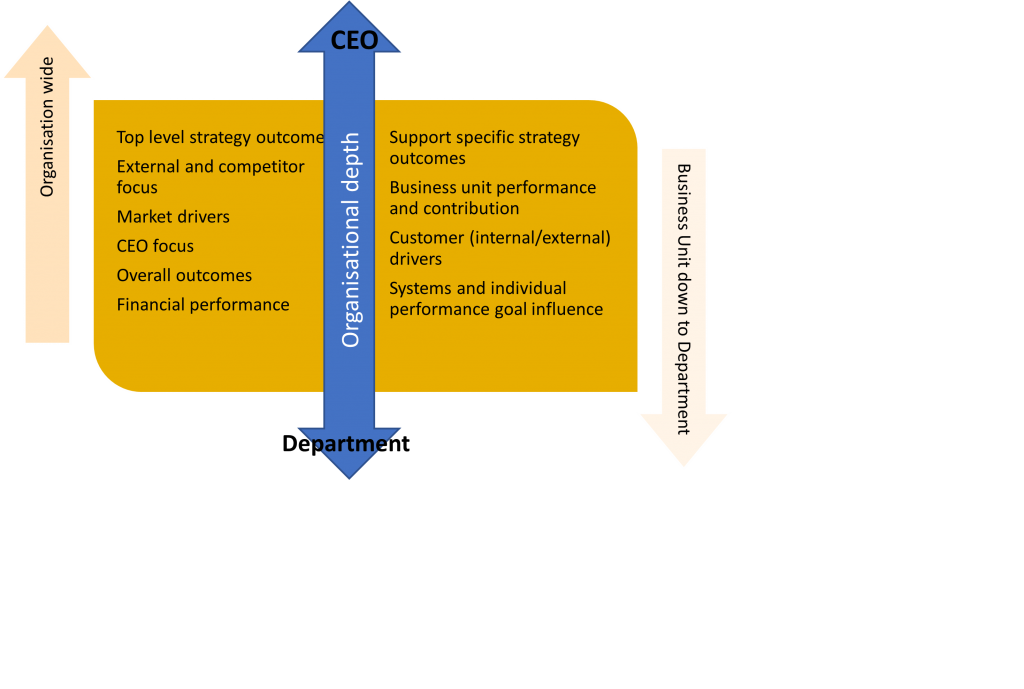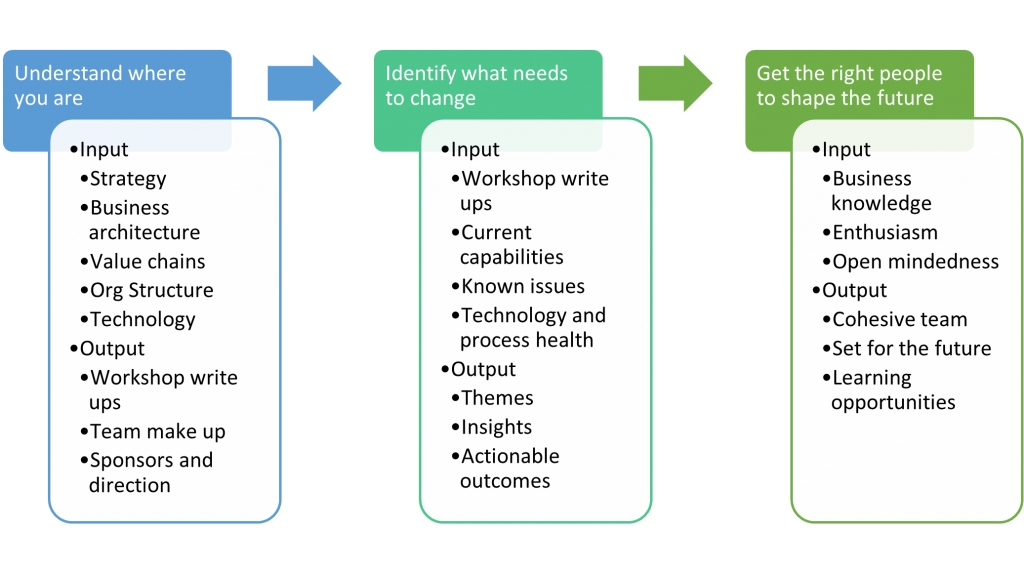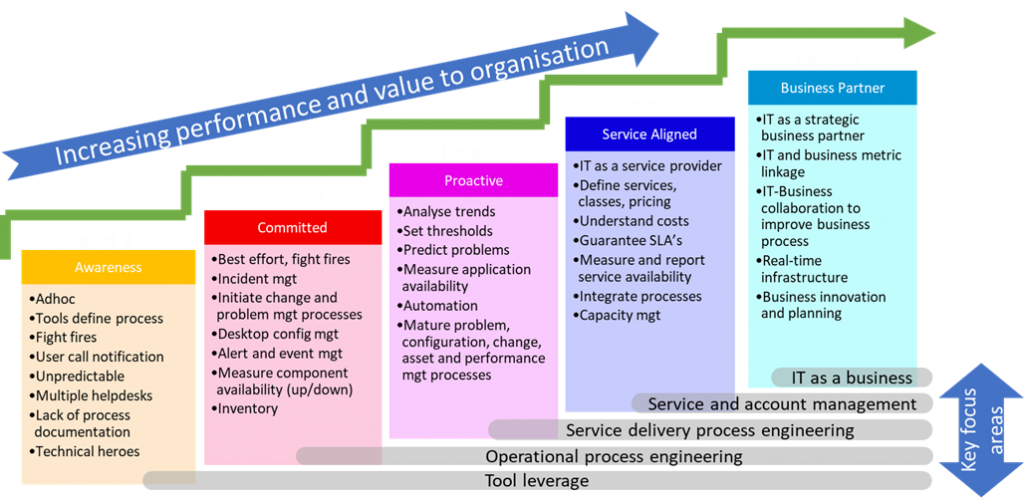Time for another in my operating model series. We have talked quite a bit about, what an operating model is, why you need one, how to build your operating model and, how to change the operating model. What we have not discussed is how to assess your operating model as it stands, and what the level of maturity may be that your organisation has in respect of the operating model.
Your operating model turns your strategy (the why) into operating (how things are actually done). It effectively provides “the what”, what needs to be done across the key aspects of your business: – process, structure, systems, culture, governance, etc. The assessment takes a critical but non-judgemental view of the operating model and the capabilities it provides to see how well the operating model supports the strategy.
Normally an operating model assessment takes 4 to 6 weeks depending on the complexity and scope. Remember this is just an assessment not the design of next steps or the production of the next gen operating model.
Remember that an operating model can live at multiple levels so, one needs to carefully look at the appropriate scope of the above points e.g., it is no good working on the operating model for a finance department if you provide information related to the whole business which is a health care provider (though some is required). This comes back to a point in one of my previous articles that talked about how strategy must flow up and down the organisation.

Many organisations will find that the top-level strategy is not well communicated down the line and/or the intent is changed. This usually then impacts the operating model negatively as, either the organisation is then set up incorrectly or the value chain outcomes are incorrect. Secondly if the operating model has not been critically examined for some time you will find complexity has been introduced as groups have tried to forge their own path in pursuit of growth or capability. You will find this has led to unwitting complexity across process and organisation and often duplication in technology and organisation.
When
Not every change in strategy requires operating model change, the typical yearly strategy update usually does not require changes to the operating model. Typically, the following types of significant strategy change mean you need to take an assessment of your operating model:
- Centralisation or decentralisation change
- Significant change in your value proposition to customers
- Acquisitions
- Business strategy pivot – product to customer or similar
- Take on significant new capability like cloud
- Significant outsourcing or potentially more likely insourcing
So, how do you actually do the assessment? Remember the inputs and outputs are relevant to the scope of the assessment.

Understand where you are
The understanding should be divided into a few stages: – pre-work, interviews/workshops, analysis and, initial outcomes.
Pre-work involves pulling together the information required to start the assessment.
- Good grasp of the strategy and reasonably well documented strategy,
- Value chains understood and documented to some extent, key processes that support the value chain,
- Organisation structure,
- Functions / business architecture – usually this is not well documented but ‘understood’ though understanding and definition can vary significantly
- Technology health that supports the operating model
Much of the information gathered can be expanded or checked at a set of interviews or workshops with key people and groups. These workshops should be open-ended rather than closed questions and give the time for people to speak and understand they have been heard. This also gives you a view of how well the overall strategy of the organisation has trickled down. Try to have people of the same group and level at the workshops some people are not intimidated by hierarchy. Prepared questions/pointers must focus on operating model topics rather than free for all otherwise general grievances come out. This also means management of the workshops must focus on the outcomes needed.
Initial analysis should focus on the common key issues and that people believe are holding them back from delivering the required outcomes and, the health of the required capabilities across people, process and technology. Understand how their view of strategy and outcomes is different from and/or shaped by the overall strategy. Are the capabilities aligned with strategy? Are they effective? Does this part of the organisation have it resources focused on the right things and in the right way? This gives you a start on the analysis stage.
It is important to communicate your findings as they become clearer to the sponsor. This will ensure that you have the support and have direction on the appropriate communication to the rest of the organisation.
Identify what needs to change
Identifying what needs to change will be both simple and complex, it is rarely one or the other. To do this we need to:
- Understand the maturity of the organisation and where it wants to get to from a maturity perspective,
- Identify capabilities, process, organisation, or technology that is not supporting the strategic direction and,
- Check that the basis of your operating model is still aligned to the strategy.
The maturity of the organisation is a key point of view to take as effectively the current maturity determines where you can get to and the ability of the organisation to adapt to change. I am not going to go deeply into maturity models – that could be a subject for another article. Suffice to say the maturity model will be different – well the specific view will be but, the structure will be the same or very similar. Below is one I adapted from Gartner’s IT Infrastructure maturity model. https://www.gartner.com/en

Key points to remember:
- You cannot jump maturity levels
- Most people when you talk to them believe they are at a higher maturity level than they actually are
- All aspects of a maturity level most be in place before an organisation can ‘graduate’ from one level to another
The analysis of the workshops and documentation with give you a particularly good view of where the organisation sits on the maturity scale. The trick will be convincing stakeholders and interested parties that your assessment is valid. Once you can agree on the approximate level of maturity you can then tailor your assessment and recommendations suitable to the ability of the organisation to take on required changes.
The capabilities, processes, technology and organisation should come from existing documentation or become apparent from workshops and other discussions. You are not expected or should intend to go into nth levels of detail (that is a full business architecture piece of work) but to understand where the issues (from the workshop analysis) are in relation to those core aspects and be able to map the issues to the appropriate core aspect. You need to be able to relate the issues and the impacts in relation to the core aspects, in a way that shows clear business detriment – increased cost, reduced throughput, inefficient organisation, technology alignment, etc.
The third part of this section is to review and identify how the basis of your current operating model – principles, value chain, etc. – match (or not) the current desired state. We are not trying state the next steps here, that is another task that is not part of assessment, we just need to identify and call out mismatches, why there is a mis-match and the impact.
Many of the disconnects between what is currently happening and what the strategy implies (don’t forget that an operating model is driven off strategy) will become apparent from the workshops. Picking the trends and themes and then relating this to how the operating model is working or not, takes more skill – not all issues will be obvious, keep lines of communication open and be will to check-in, discuss and amend based on feedback to ensure what you are delivering is relevant and understandable by the sponsor(s) and their teams.
Get the right people to shape the future
Performing the assessment, understand the existing model and what could be done, requires the right people. This is both on the execution and those making decisions on the assessment. Having the people with some out of the box thinking sponsoring and working within the assessment can help break the corporate think. This is also why many organisations use outside help to do assessments.
Having people who understand the business and what needs to change though combined with outside thinking often provides some of the best results. The sponsors are key in supporting and challenging the work and helping drive to the most pragmatic but also transforming output.
Final thoughts
The assessment can be a deep or shallow as you need or have time to afford. There is probably a minimum time of 3-4 weeks to do a basic assessment of part of a business, like IT Operations. The assessment gives you the data to help decide what to do next.
A few tips:
- If there is not a clear strategy (even if not well articulated) or intent to change then don’t do this work
- Sponsorship and the right sponsors are key
- The organisation needs to be able accept and act on change – don’t forget about change fatigue
- Communicate back early and often
- Gain commitment that the outcome will be acted on before starting


